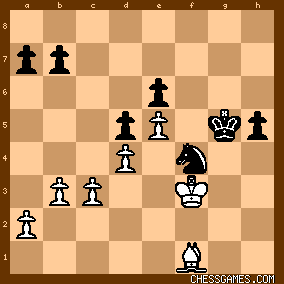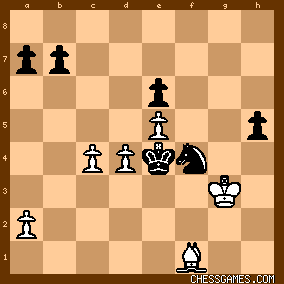| KEG: A beautifully played endgame by Lasker. Pleasing as Lasker's play is in this classic Knight versus Bishop ending, it is spoiled by Showalter's zombie-like play in the ending and the terrible commentary in the Tournament Book. Showalter tried to attack Lasker in the middle-game by advancing his g pawn, but this got him nowhere, and Lasker got the better game. Instead of trying to convert his middle-game edge, Lasker allowed the game to be reduced to an ending in which his edge was gone. He did this--no doubt--because he was sure he could win any even approximately equal ending against Showalter. As the course of the game demonstrates, Lasker was correct. According to the Tournament Book, Lasker went into this endgame because his pawn majority on then King's side gave him an advantage. This is nonsense. The diagram below shows the position after 29...KxR: 
click for larger viewDoes Black (Lasker) have an edge here? Hardly! That Lasker managed to secure resignation from this position in just 17 moves is testament to his incredible endgame skill and Showalter's incredibly weak play from this point on. I would venture to say that had Lasker had the White pieces against Showalter in this position, he would have won equally easily. To put it bluntly, Showalter was no match for Lasker in the endgame. In the diagrammed position, Showalter could have maintained his tiny edge with 30. Bc2 or 30. Kh2 or just about anything other than his actual move of 30. Kf2. This allowed Lasker to fork Showalter's Bishop and Pawn with 30...Nf4. Compare the position after 30...Nf4 with the position one move earlier and the progress Lasker made is obvious. 
click for larger viewNow Showalter had to play 31. Bf1. He was still OK (the Tournament Book's claim that he was lost here is ridiculous) but now Lasker was in his element, and began exploiting his edge on the King's side by advancing his KNP and KRP. After Lasker's 33rd move, the position was this: 
click for larger viewAs is obvious, Lasker has something going on the King's side, but as is also obvious Showalter had chances to obtain counterplay on the other wing. With something like 34. Bb5, the game would have been even. Instead, Showalter played the lemming-like b3. A look at the position two moves later shows the progress Lasker had made after swapping a pair of pawns on the King's side: 
click for larger viewShowalter's position is hardly beyond repair, but now he needed to play with great care. Instead, he created a weakness on the Queen's side with 36. c4, allowing Lasker to make another advantageous swap. After Lasker
s 37...Kf5, the situation was becoming critical for Showalter: 
click for larger viewThe threat of Lasker's running h pawn was bad enough. What Showalter could not afford was to allow Lasker to obtain threats on the other side while his (Showalter's) King was tied down on the opposite wing. He also needed to guard his center pawns. Showalter could have made a game of it in the diagrammed position with 38. c5, tying down Lasker's b pawn. Instead, Showalter played 38. Kg3 and Lasker was off to the races with 38...Ke4: 
click for larger viewWhat followed was carnage! | 




































